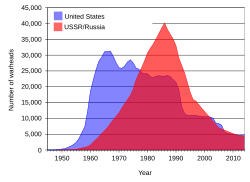Nuclear disarmament
Nuclear disarmament talks about the act of reducing or eliminating nuclear weapons and to the end state of a nuclear-weapon-free world, in which nuclear weapons are completely eliminated.
Nuclear disarmament groups include the Campaign for Nuclear Disarmament, Peace Action, Greenpeace, International Physicians for the Prevention of Nuclear War, Mayors for Peace, Global Zero, the International Campaign to Abolish Nuclear Weapons (winner of the Nobel Peace Prize in 2017), Nihon Hidankyo (winner of Nobel Peace Prize in 2024) and the Nuclear Age Peace Foundation.
There have been many large anti-nuclear demonstrations and protests. On June 12, 1982, one million people demonstrated in New York City's Central Park against nuclear weapons and for an end to the cold war arms race. It was the largest anti-nuclear protest and the largest political demonstration in American history.[2][3]
In recent years, some U.S. elder statesmen have also advocated nuclear disarmament. Sam Nunn, William Perry, Henry Kissinger, and George Shultz have called upon governments to embrace the vision of a world free of nuclear weapons, and in various op-ed columns have proposed an ambitious program of urgent steps to that end. The four have created the Nuclear Security Project to advance this agenda. Organisations such as Global Zero, an international non-partisan group of 300 world leaders dedicated to achieving nuclear disarmament, have also been established.
Nuclear Disarmament Media
The mushroom cloud over Hiroshima after the dropping of the atomic bomb nicknamed 'Little Boy' (Atomic bombings of Hiroshima and Nagasaki in 1945).
Mushroom-shaped cloud and water column from the underwater nuclear explosion of July 25, 1946, which was part of Operation Crossroads.
November 1951 nuclear test at the Nevada Test Site, from Operation Buster, with a yield of 21 kilotons. It was the first U.S. nuclear field exercise conducted on land; troops shown are 6 mi (9.7 km) from the blast.
1952 World Peace Council congress in East Berlin showing Picasso peace dove above the stage
Women Strike for Peace during the Cuban Missile Crisis in 1962
Demonstration in Lyon, France, in the 1980s against nuclear weapons tests
On December 12, 1982, 30,000 women held hands around the 6-mile (9.7 km) perimeter of the RAF Greenham Common base to protest the decision to site American cruise missiles there.
United States and USSR/Russian nuclear weapons stockpiles, 1945–2014. These numbers include warheads not actively deployed, including those on reserve status or scheduled for dismantlement. Stockpile totals do not necessarily reflect nuclear capabilities since they ignore size, range, type, and delivery mode.
UN Representative for Disarmament Affairs, Angela Kane, at a 2012 ceremony marking the anniversary of the Hiroshima and Nagasaki atomic bombings
References
- ↑ "BBC NEWS : Magazine : World's best-known protest symbol turns 50". BBC News (London). 20 March 2008. http://news.bbc.co.uk/1/hi/magazine/7292252.stm. Retrieved 2008-05-25.
- ↑ Jonathan Schell. The Spirit of June 12 Archived 2019-05-12 at the Wayback Machine The Nation, July 2, 2007.
- ↑ "1982 - a million people march in New York City". Archived from the original on 2008-05-16. Retrieved 2016-01-30.









